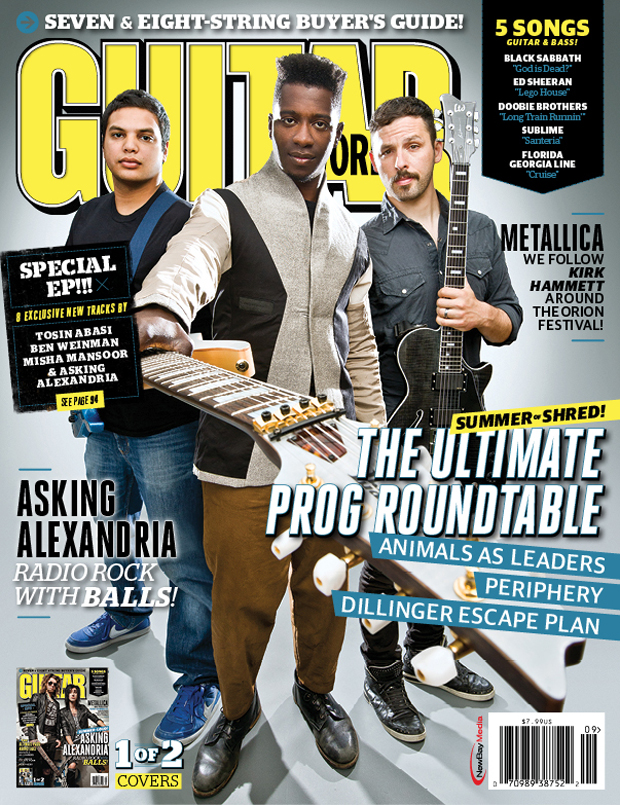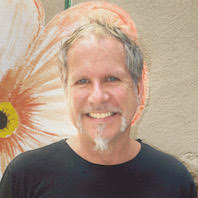Power Trio: Tosin Abasi, Misha Mansoor and Ben Weinman — the Ultimate Prog Roundtable

This is an excerpt from the September 2013 issue of Guitar World magazine. For the rest of this story, plus a Tosin Abasi poster and features on Metallica's Kirk Hammett, a seven- and eight-string buyer's guide and more, check out the September 2013 issue at the Guitar World Online Store.
They started like most of us, playing power chords, Nirvana and Metallica. So how exactly did Ben Weinman of the Dillinger Escape Plan, Animals as Leaders’ Tosin Abasi and Periphery’s Misha Mansoor become such damned good guitarists?
“Hey, let me try something,” Dillinger Escape Plan’s Ben Weinman says to photographer Jimmy Hubbard. “I’m gonna jump up, push my foot off that molding and catapult myself in the air, and I want you to take photo of it. It might look cool.”
Hubbard and I are skeptical. We are standing with the guitarist in a narrow corridor in the basement of Guitar World’s offices, and the wall molding is a good three or four feet up from the ground. It’s hard to believe that Weinman will be able to jump that high, let alone use it as leverage for his foot. We enthusiastically cheer him on, hoping to see, at very least, a classic wipeout.
Weinman grabs his guitar and, to our amazement, takes a small running start and, like Spider-Man, leaps, bounces off the wall and rockets into the air while managing to flip us both off before landing on both feet. More remarkably, he replicates this wildly strenuous parkour-style move about 15 more times, until Hubbard is able to frame the shot perfectly.
I guess we shouldn’t have been that surprised. In many ways, Weinman and our two other guests, Periphery’s Misha Mansoor and Animals as Leaders’ Tosin Abasi, do something similar almost every day of their lives. They strap on their guitars, play riffs that seem physically impossible and create music that virtually explodes into space.
Abasi and Mansoor have now joined us and are laughing and applauding Weinman’s feats of derring-do. Tosin and Misha, while not in the same band, have been close friends and musical collaborators for several years. It was Mansoor who produced Animals as Leaders’ widely hailed, self-titled 2009 debut, a dazzling instrumental showcase featuring Abasi’s innovative seven- and eight-string guitar playing. Packed with wickedly fast soloing, beautiful jazz-influenced chord voicings and tricky polyrhythms, Animals as Leaders and Weightless, its 2011 follow-up, have put Abasi on the short list of post-millennial shredders that really matter.
As for Mansoor, he’s become something of a guitar hero in his own right. Since 2009, he has produced and played guitar on two albums with his band, Periphery, a groundbreaking progressive-rock unit that fuses soaring vocal melodies and complex instrumental interludes into polished, compact, space age–sounding metal. With their distinctive three-guitar sound, glitch electronic overlays and throaty chug provided by the lower strings of their seven-string guitars, Periphery have spawned a whole underground industry of imitators.
That leaves Weinman’s band, the Dillinger Escape Plan. To describe them as “metalcore,” as many have, would be a grave injustice. Combining the raw confrontation of punk with a jagged overlay of thrash metal and avant-garde jazz, the Plan are in a category of their own. Their new album, One of Us Is the Killer, is not only aggressively unique but also one of the best rock albums released this year. (Plus, they put on one of the most physically punishing live shows in rock history.)
Together, Weinman, Abasi and Mansoor represent three of the more forward-thinking minds in modern rock guitar, and they are the perfect musicians to engage in a deep discussion on the state of modern rock and guitar playing. Not coincidently, the guitarists and their bands are all appearing on this year’s Summer Slaughter lineup, a gruesome-sounding event with unexpectedly sophisticated ambitions.
“I was never really interested in other technical bands, or bands that people claimed had a kinship with the Dillinger Escape Plan until Periphery and Animals as Leaders came along,” Weinman says. “I think what we all have in common is an original vision and, perhaps more importantly, good songs. Animals and Periphery play quality music, and it just so happens that their virtuosity is off the charts. They represent the next big thing.”
In the following roundtable, we trace each player’s rise from his humble musical origins to his current status as a virtuoso and…the next big thing.
Why did you start playing the guitar?
TOSIN ABASI I was playing clarinet in the school band—not the coolest instrument—and I started hanging out with a friend who played guitar. I had him show me how to play the beginning riff to “One” by Metallica. Immediately, I thought, Man, I want one of those.
MISHA MANSOOR I also started on another instrument. My mom had me take piano lessons when I was really young, because I showed an affinity for playing music. Unfortunately, I didn’t retain anything, because I hated the piano.
Then, when I was about 12, I had this friend that was visiting from Australia who turned me on to all the Nineties bands, like Nirvana, Green Day and Offspring, and my interest spiraled from there. I remember asking my friend, “Do you have anything louder?” What I meant was something heavier. He would play me AC/DC, and I was like, “No, I mean, louder!” As soon as I heard a distorted guitar, I was hooked.
For the rest of this story, plus a Tosin Abasi poster and features on Metallica's Kirk Hammett, a seven- and eight-string buyer's guide and more, check out the all-new September 2013 issue of Guitar World at the Guitar World Online Store.
Photo: Jimmy Hubbard

Get The Pick Newsletter
All the latest guitar news, interviews, lessons, reviews, deals and more, direct to your inbox!
A long time ago in a galaxy far, far away Brad was the editor of Guitar World from 1990 to 2015. Since his departure he has authored Eruption: Conversations with Eddie Van Halen, Light & Shade: Conversations with Jimmy Page and Play it Loud: An Epic History of the Style, Sound & Revolution of the Electric Guitar, which was the inspiration for the Play It Loud exhibition at the Metropolitan Museum of Art in New York City in 2019.
“I just learned them from the records. I don’t read tabs or anything, I don’t read music – I learned by ear”: How a teenage Muireann Bradley put a cover of Blind Blake’s Police Dog Blues on YouTube and became a standard bearer for country blues
“The Strat was about as ‘out’ as you could get. If you didn’t have a Floyd Rose, it was like, ‘what are you doing?’”: In the eye of the Superstrat hurricane, Yngwie Malmsteen stayed true to the original

